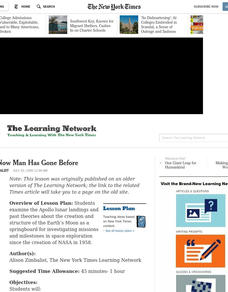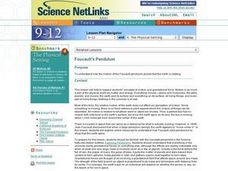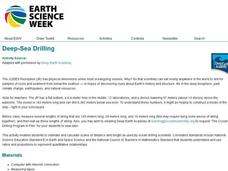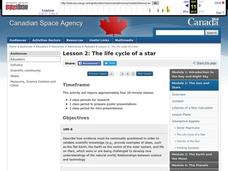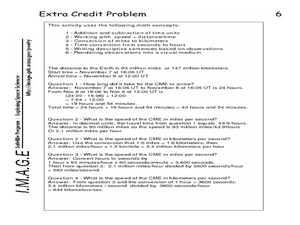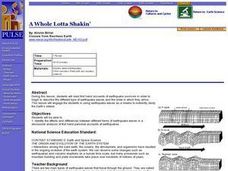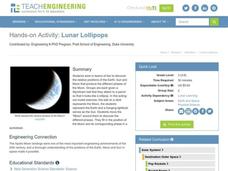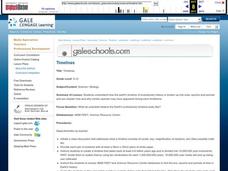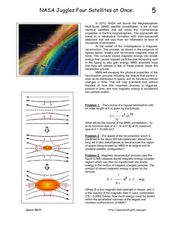Curated OER
Where Now Man Has Gone Before
Learners examine the Apollo lunar landings and past theories about the creation and structure of the Earth's Moon as a springboard for investigating missions and milestones in space exploration since the creation of NASA in 1958.
Curated OER
How Do Things Fall?
Students study forces by examining the force of gravitational attraction. They observe how objects fall and measure the force of gravitational attraction upon objects. Students discover that, since gravitational constants are different...
Curated OER
Foucault's Pendulum
Students investigate how the motion of the Foucault pendulum proves that the Earth is rotating. They research the Internet about pendulums and conduct an experiment online. They view a multimedia presentation about pendulums and read...
Curated OER
Deep Sea Drilling
Students explore ocean vessels that drill the ocean floor. In this ocean drilling lesson plan, students watch videos about drilling the ocean floor and discuss. Students get into groups, go outside and use string to mark off...
Curated OER
The Life Cycle of a Star
Students investigate the life cycle of a star and make conclusions based on evidence, research, and observation. In this lesson on space and scientific investigation, students describe the relationships between science and...
Curated OER
Cooler in the Shadows
Students explore Earth science by creating a scale model in class. In this shadow lesson plan, students research the impact the sun has on Earth shadows and complete a space science worksheet. Students create models of the Sun and Earth...
Curated OER
Solar and Auroral Events
In this solar and auroral events worksheet, learners answer 5 questions about a coronal mass ejection that traveled to the Earth. They find the time it took to arrive and they determine the speed of the coronal mass ejection in...
Curated OER
Mass Spectrometer
In this mass spectrometer worksheet, students read about how a mass spectrometer determines the elements in gases around Earth. Students answer 3 questions and identify the elements in a graph found by a mass spectrometer.
Curated OER
A Whole Lotta Shakin'
Students read first hand accounts of earthquake survivors in order to begin the describe the different types of earthquake waves and the order in which they arrive. They engage in using earthquake waves as a means to indirectly study the...
Curated OER
The Plasmasphere
In this plasmasphere worksheet, learners read about the dilute region of gases 10,000 kilometers above the Earth where atoms are ionized. Students use a photograph taken by the IMAGE EUV instrument to answer 3 questions about the...
Curated OER
How Hot is that Planet?
In this planet activity, high schoolers read about finding the temperature of a planet using the distance to its star, its reflectivity and the luminosity of the star. Students use a given equation to determine the surface...
Curated OER
The Transit of Mercury
In this transit of Mercury worksheet, learners read about Earth and Mercury lining up so that Mercury passes across the disk of the sun from the Earth's view. Students solve 3 problems and they determine the diameter of the solar disk...
Curated OER
Lunar Lollipops
Students work with a partner, Styrofoam ball and light source to simulate the positions of the Earth, Moon and Sun at various stages during the phases of the Moon. They describe why the Moon is visible from Earth and complete a worksheet.
Curated OER
And a Star to Steer Her By: A Field Trip Guide for the Planetarium Show
In this field trip study guide for the planetarium show lesson, students construct a model of the Earth and describe the relative positions of the continents using latitude and longitude. Students construct a star chart to find...
Curated OER
Solar Storm Timeline
For this solar storm timeline, learners read about a series of events that took place in space beginning with a solar flare. Students gather the information and create a time line of events mentioned. They determine the length of time it...
Curated OER
Ocean Currents and Sea Surface Temperature
Students use satellite data to explore sea surface temperature. They explore the relationship between the rotation of the Earth, the path of ocean current and air pressure centers. After studying maps of sea surface temperature and ocean...
Curated OER
What is Momentum?
In this momentum learning exercise, students will calculate the maximum forward momentum of the Apollo 11 lunar spacecraft at three different stages of its space travel.
Curated OER
Seeing Solar Storms in STEREO-I
In this geometric calculations of solar storms instructional activity, students use a diagram indicating the location of 2 STEREO satellites, the earth and the sun to calculate the distance between a Coronal Mass Ejection and the Earth....
Curated OER
The Last Total Solar Eclipse...Ever!
In this total solar eclipse worksheet, students solve 7 problems about the angular size of the moon, the distance the sun and moon should be to match in diameter, the number of years it will take for the moon to be at a certain distance...
Curated OER
SDO Reveals Details on the Surface of the Sun
In this images of the sun worksheet, students read about the images released by NASA's Solar Dynamics Observatory and they solve 3 problems using the given photograph of the sun. Students find the scale of the image, they compare the...
Curated OER
MAPPING THE TOPOGRAPHY OF UNKNOWN SURFACES
Students describe in words and graphic displays the elevation or depression profile of sections of Mars' Olympus Mons and/or Valles Marineris. They explain how orbiting spacecraft build up global maps one data slice at a time.
Curated OER
Timelines
High schoolers examine evolutionary history; the earth's timeline by creating timelines. They determine the timeframes of era, epochs, and periods and study the species that were evident in each.
Curated OER
Weather
Learners explore the earth's atmosphere, weather, and climate. They begin class with a discussion about weather patterns, atmosphere, and the layers of the earth. After the class discussion, students rotate through four stations to...
Curated OER
NASA Juggles Four Satellites at Once
In this NASA satellites worksheet, students read about the Magnetosphere Multi-Scale satellite constellation that NASA will launch in 2013. They solve 4 problems including finding the volume of the MMS constellation, finding how long it...
Other popular searches
- Earth Space Science
- Earth and Space
- Earth in Space
- +Earth and Space Science
- Earth Space Science Quiz
- Earth Movement in Space
- Inquiry Earth Space Science
- Earth Rotation Space
- Space and Earth Science
- Earth Space
- Seeing Earth From Space
- Earth and Space Sciences
